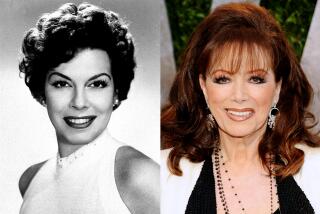Women Who Ran With the Wolves
- Share via
Wellesley can have Hillary Rodham Clinton. Smith is welcome to Barbara Bush. At Vassar we hail the Jackies. That’s Jackie O., ‘51, she of the the Bonwit Teller sunglasses and hair by Kenneth; and Jackie St. James, ‘74, a fashionable gender-bender, fabulous and almost as famous as his namesake.
Jackie the younger made Vassar history as the first student to be elected class president three years in a row. His gender bending, we discover in “Wolf Girls at Vassar: Lesbian and Gay Experiences 1930--1950,” a compilation of reminiscences edited by Anne Mackay, ‘49, with an introduction by Lillian Faderman, was perhaps more iconic than iconoclastic.
The lupine types of the title are, strictly speaking, Gail Dunlap and Christina Biaggi, ‘59ers both; their own wont of referring to each other with the masculine pronoun, slipping into Arctic wolf-skins and howling at the moon may not have been widespread, but their “sapphic affinity” (Dunlap’s term) falls in with a campus tradition as old as the Daisy Chain.
An 1866 catalogue advised prospective Vassar women that dorm rooms came furnished with either single or double beds, “to suit the different tastes of the students.” From its earliest days, MacKay tells us, the college’s “matriarchal” set-up along with its idyllic setting fostered fierce romantic attachments, or “smashes.” The smashed would deploy bouquets, notes, candies, locks of hair--anything to conquer her inamorata: “If only God had let us love--and show the world the way!” versified Edna St. Vincent Millay (who entered Vassar in 1913 and answered to “Vincent” on campus) of a frustrated smash. A generation later, Mary McCarthy helped immortalize another Vassar poet by reportedly modeling the character of Lakey, the paradigmatic lipstick lesbian in the novel “The Group,” after her classmate Elizabeth Bishop. (You may remember Candice Bergen brandishing her crisply tailored suits and baroness lover in the movie version.)
By the time the older contributors to this collection entered Vassar, administrative fears about the existence of “lesbian rings” had prompted a crackdown. “A witch hunt, albeit a quiet one, was whipping through the place,” remembers Betsy Crowell, ’60.
In other words, Vassar in the ‘50s was pretty much in step with the rest of the country. The major academic and cultural currents of the next decades--coeducation, feminism, multiculturalism, as well as post-Stonewall activism would, of course, buoy the gay presence there. But this is a volume of voices, not isms , of wolf girls and Jackies and everything in between. Hear then: Beva Eastman, ‘61: “I went to dinner at a faculty home my sophomore year with the eager expectation of hearing about the lives of two women faculty I admired. When the evening opened with a discussion of Milton’s shell imagery, I knew we were going into academic hiding.” Anonymous, ‘78: “I found myself wanting to be more than just her friend, but I didn’t know how to go about it. Being a true Vassar girl, I decided to research the matter. I can’t quite believe this now, but I remember very distinctly going out fishing that summer with my father. While he trolled for ‘muskies,’ I sat in the boat and read ‘Lesbian Nation, Lesbian Woman’ and ‘Sappho Was a Right-On Woman.’
More to Read
Sign up for our Book Club newsletter
Get the latest news, events and more from the Los Angeles Times Book Club, and help us get L.A. reading and talking.
You may occasionally receive promotional content from the Los Angeles Times.










